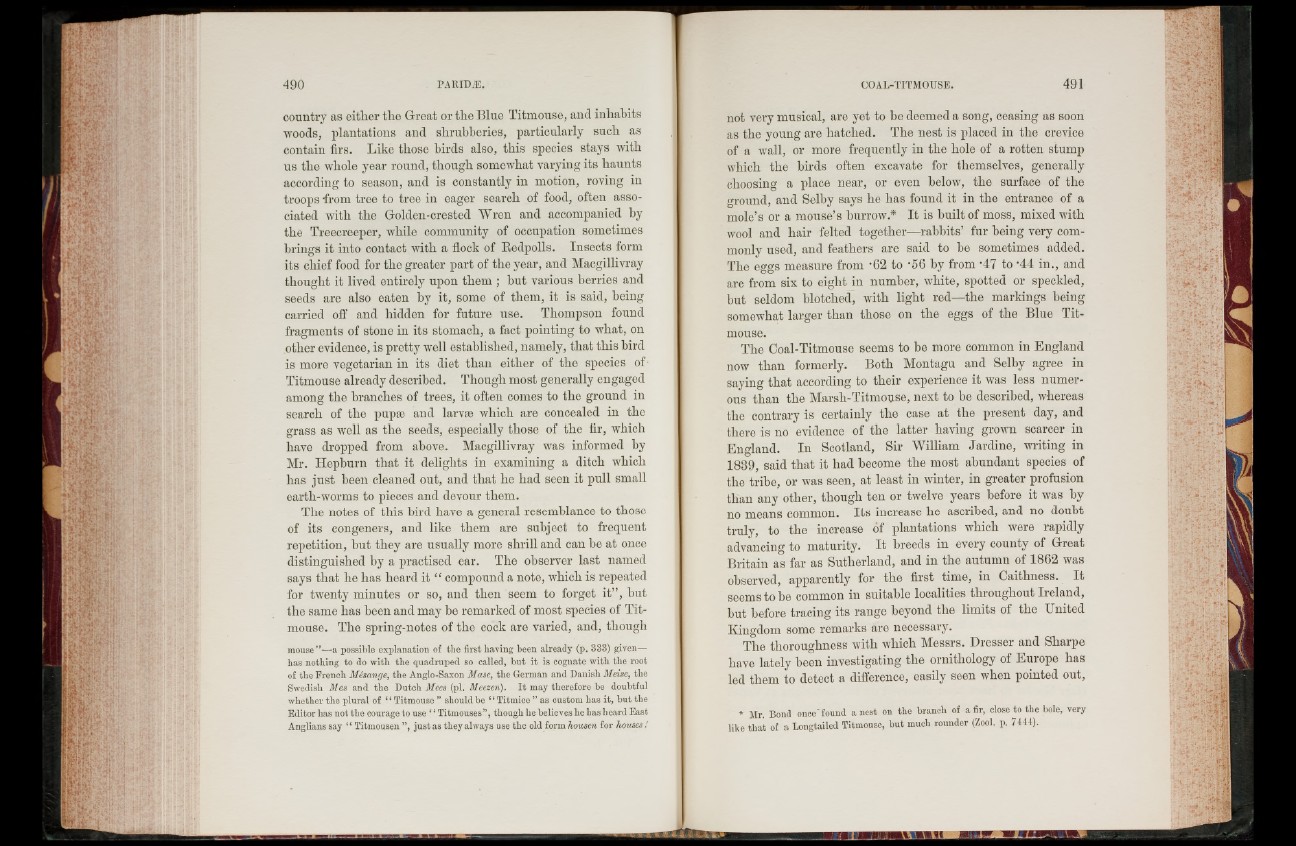
country as eitlier the Great or the Blue Titmouse, and inhabits
woods, plantations and shrubberies, particularly such as
contain firs. Like those birds also, this species stays with
us the whole year round, though somewhat varying its haunts
according to season, and is constantly in motion, roving in
troops -from tree to tree in eager search of food, often associated
with the Golden-crested Wren and accompanied by
the Treecreeper, while community of occupation sometimes
brings it into contact with a flock of Kedpolls. Insects form
its chief food for the greater part of the year, and Macgillivray
thought it lived entirely upon them ; hut various berries and
seeds are also eaten by it, some of them, it is said, being
carried off and hidden for future use. Thompson found
fragments of stone in its stomach, a fact pointing to what, on
other evidence, is pretty well established, namely, that this bird
is more vegetarian in its diet than either of the species of
Titmouse already described. Though most generally engaged
among the branches of trees, it often comes to the ground in
search of the pupae and larvae which are concealed in the
grass as well as the seeds, especially those of the fir, which
have dropped from above. Macgillivray was informed by
Mr. Hepburn that it delights in examining a ditch which
has just been cleaned out, and that he had seen it pull small
earth-worms to pieces and devour them.
The notes of this bird have a general resemblance to those
of its congeners, and like them are subject to frequent
repetition, but they are usually more shrill and can be at once
distinguished by a practised ear. The observer last named
says that he has heard it “ compound a note, which is repeated
for twenty minutes or so, and then seem to forget it” , but
the same has been and may be remarked of most species of Titmouse.
The spring-notes of the cock are varied, and, though
mouse ”—a possible explanation of the first haying been already (p. 333) given—
has nothing to do with the quadruped so called, but it is cognate with the root
of the French Mesange, the Anglo-Saxon Masc, the German and Danish Meisc, the
Swedish Mes and the Dutch Mees (pi. Meezeri). I t may therefore be doubtful
whether the plural of “ Titmouse ” should be “ Titmice ” as custom has it, but the
Editor has not the courage to use ‘ ‘ Titmouses”, though he believes he has heard East
Anglians say 1 ‘ Titmousen ” , just as they always use the old form housen for houses!
not very musical, are yet to be deemed a song, ceasing as soon
as the young are hatched. The nest is placed in the crevice
of a wall, or more frequently in the hole of a rotten stump
which the birds often excavate for themselves, generally
choosing a place near, or even below, the surface of the
ground, and Selby says he has found it in the entrance of a
mole’s or a mouse’s burrow.* I t is built of moss, mixed with
wool and hair felted together—rabbits’ fur being very commonly
used, and feathers are said to be sometimes added.
The eggs measure from ’62 to -56 by from -47 to -44 in., and
are from six to eight in number, white, spotted or speckled,
but seldom blotched, with light red—the markings being
somewhat larger than those on the eggs of the Blue Titmouse.
The Coal-Titmouse seems to he more common in England
now than formerly. Both Montagu and Selby agree in
saying that according to their experience it was less numerous
than the Marsh-Titmouse, next to be described, whereas
the contrary is certainly the case at the present day, and
there is no evidence of the latter having grown scarcer in
England. In Scotland, Sir William Jardine, writing in
1839, said that it had become the most abundant species of
the tribe, or was seen, at least in winter, in greater profusion
than any other, though ten or twelve years before it was by
no means common. Its increase he ascribed, and no doubt
truly, to the increase of plantations which were rapidly
advancing to maturity. It breeds in every county of Great
Britain as far as Sutherland, and in the autumn of 1862 was
observed, apparently for the first time, in Caithness. It
seems to be common in suitable localities tlnoughout Iieland,
but before tracing its range beyond the limits of the United
Kingdom some remarks are necessary.
The thoroughness with which Messrs. Dresser and Sharpe
have lately been investigating the ornithology of Europe has
led them to detect a difference, easily seen when pointed out,
* Mr. Bond once" found a nest on the branch of a fir, close to the bole, very
like that of a Longtailed Titmouse, but much rounder (Zool. p. 7444).